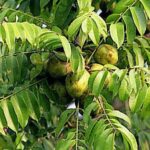Taro (Colocasia esculenta (L.) Schott) is one of the three staple food items of the Mentawai people on Siberut Island in Indonesia. The other two are sago and bananas. In many other countries, taro leaves and corms are eaten. Mentawais prefer just eating corms and eat leaves only occasionally. Before imported tobacco arrived, dried taro leaves were rolled into cigars and used as a stimulant.
Taro plants on Siberut Island.
Two types of taro cultivars exist: Colocasia sp and Xhantosoma sp. At Siberut Island, most taro types are Colocasia species with one bulb. Mentawais cultivate taro in dedicated patches of swampy areas. Most of these so-called gardens appear wild and are located next to rivers. They are usually tightly fenced with small, pruned shrubs to keep pigs out. Women typically tender taro gardens. Only occasionally, men may help their wives to plow the garden or erect fences. Besides taro, these cultivated patches of land also contain coconut trees, bananas, sugar cane, cassava, sweet potato, or other edible plants.


Taro corms planted and harvested during my stay with Mentawai people were of a type that had lots of rootlets on the bulb. It appeared to be not a highly cultivated type but seemed to be quite wild. The white corms contained light purple fibers due to phenolic pigments.
Processing of taro corms
In its raw form, the plant is toxic due to calcium oxalate and needle-shaped raphides in the plant cells. However, the toxin can be minimized, and the tuber is rendered palatable by cooking or steeping in cold water overnight.
The first step in processing the corms is peeling them. After that, they are cut into half, and each half is quartered again. These taro wedges will now be boiled together with a similar amount of bananas in thick bamboo tubes over one of the fires in the Uma (Mentawai family home in the forest).


When boiled to the required softness, the bamboo tube is split open, and the taro wedges and bananas are ladled onto a wooden tray. There, they are smashed and ground into a thick paste.
The mashed, thick taro & banana dough is formed into elongated dumplings, then rolled in grated coconut.
Eating taro

Boiled meat is always eaten with sago sticks. Taro & banana dumplings rolled in coconut (called ‘Subbed’ in the Mentawai language) are a special treat at family gatherings and ceremonies.

The taste of these doughy dumplings is rather bland, but they have a subtle sweet and nutty aftertaste that is quite addictive.
Nutritional value of taro corms
According to Wikipedia, based on the USDA database, cooked taro corms contain:
- 64% water,
- 35% carbohydrates
- negligible protein and fat
But taro corms are a rich source of:
- Vitamin B6 (25% Daily Value / DV),
- Vitamin E (20% DV),
- Manganese (21% DV),
- Phosphorus and potassium are contained in moderate amounts (11 and 16 % DV)
The energy content of taro corms = 142 kcal/100 grams (3.5 oz). The contained starch is easily digestible, and because the smashed corms have a smooth texture, they are also used as baby food.
Lessons learned from taro as a staple food of Mentawais:
- Taro is one of the three staple food items for the Mentawai people.
- While men are responsible for providing sago, women grow and harvest taro.
- Taro corms are made edible by boiling them.
- Typical Mentawai food is taro & banana dumplings rolled in grated coconut.
.





